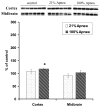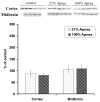Resuscitation with 100%, compared with 21%, oxygen following brief, repeated periods of apnea can protect vulnerable neonatal brain regions from apoptotic injury
- PMID: 17765386
- PMCID: PMC2610457
- DOI: 10.1016/j.resuscitation.2007.07.022
Resuscitation with 100%, compared with 21%, oxygen following brief, repeated periods of apnea can protect vulnerable neonatal brain regions from apoptotic injury
Abstract
Purpose: To determine the effect of repeated intermittent apnea and resuscitation with 100% vs. 21% oxygen enriched gas on levels of key regulatory proteins contributing to cell death (Bax, Caspase-3) or protecting neurons from hypoxic/ischemic injury (Bcl-2, p-Akt, p-CREB).
Methods: The anaesthetized, mechanically ventilated newborn piglets underwent 10 episodes of apnea with resuscitation either with 100% or with 21% oxygen. Following 6h recovery the animals were sacrificed painlessly, the brain dissected out and used to determine levels of Bcl-2, Bax, Caspase-3, p-Akt and p-CREB in the striatum, frontal cortex, midbrain and hippocampus were studied.
Results: In hippocampus and striatum, Bcl-2 expression was higher with 100% vs. 21% group (173+/-29% vs. 121+/-31%, p<0.05 and 189+/-10% vs. 117+/-47%, p<0.01, respectively) whereas the Bax expression was lower (88+/-3% vs. 100+/-9%, p<0.05 and 117+/-5% vs. 133+/-10%, p<0.05, respectively). Expression of Caspase-3 in the striatum, was lower with 100% vs. 21% group (197+/-35% vs. 263+/-33%, p<0.05, respectively) but not different in the hippocampus. p-Akt expression was higher with 100% vs. 21% oxygen in the hippocampus and striatum (225+/-44% vs. 108+/-35%, p<0.01 and 215+/-12% vs. 164+/-16%, p<0.01, respectively). The p-CREB expression was higher with 100% vs. 21% oxygen resuscitation in the hippocampus (217+/-41% vs. 132+/-30%, p<0.01) with no changes in striatum. Much smaller or insignificant differences between 100% vs. 21% oxygen groups were observed in the frontal cortex and midbrain, respectively.
Conclusion: In neonatal piglet model of intermittent apnea, selectively vulnerable regions of brain (striatum and hippocampus) are better protected from apoptotic injury when resuscitation was conducted with 100%, rather than 21%, oxygen.
Figures










Similar articles
-
Response of brain oxygenation and metabolism to deep hypothermic circulatory arrest in newborn piglets: comparison of pH-stat and alpha-stat strategies.Ann Thorac Surg. 2007 Jul;84(1):170-6. doi: 10.1016/j.athoracsur.2007.02.010. Ann Thorac Surg. 2007. PMID: 17588406 Free PMC article.
-
Brain oxygen and metabolism is dependent on the rate of low-flow cardiopulmonary bypass following circulatory arrest in newborn piglets.Eur J Cardiothorac Surg. 2007 May;31(5):899-905. doi: 10.1016/j.ejcts.2007.01.049. Epub 2007 Mar 1. Eur J Cardiothorac Surg. 2007. PMID: 17336082
-
Effect of granulocyte-colony stimulating factor on expression of selected proteins involved in regulation of apoptosis in the brain of newborn piglets after cardiopulmonary bypass and deep hypothermic circulatory arrest.J Thorac Cardiovasc Surg. 2012 Jun;143(6):1436-42. doi: 10.1016/j.jtcvs.2012.01.018. Epub 2012 Feb 4. J Thorac Cardiovasc Surg. 2012. PMID: 22306220 Free PMC article.
-
The effect of hypothermia on neuronal viability following cardiopulmonary bypass and circulatory arrest in newborn piglets.Eur J Cardiothorac Surg. 2009 Apr;35(4):577-81; discussion 581. doi: 10.1016/j.ejcts.2009.01.001. Epub 2009 Feb 13. Eur J Cardiothorac Surg. 2009. PMID: 19217795 Free PMC article.
-
Cardiac arrest: the effect on the brain.Am J Nurs. 2003 Jun;103(6):50-4; quiz 55. doi: 10.1097/00000446-200306000-00023. Am J Nurs. 2003. PMID: 12802155 Review. No abstract available.
Cited by
-
Reoxygenation of asphyxiated newborn piglets: administration of 100% oxygen causes significantly higher apoptosis in cortical neurons, as compared to 21%.Biomed Res Int. 2014;2014:476349. doi: 10.1155/2014/476349. Epub 2014 Mar 25. Biomed Res Int. 2014. PMID: 24783208 Free PMC article.
-
A Dual Role for Hyperbaric Oxygen in Stroke Neuroprotection: Preconditioning of the Brain and Stem Cells.Cond Med. 2018 Jun;1(4):151-166. Cond Med. 2018. PMID: 30079404 Free PMC article.
-
Hyperbaric oxygen therapy promotes neurogenesis: where do we stand?Med Gas Res. 2011 Jun 27;1(1):14. doi: 10.1186/2045-9912-1-14. Med Gas Res. 2011. PMID: 22146131 Free PMC article.
-
Resuscitation of newborn piglets. short-term influence of FiO2 on matrix metalloproteinases, caspase-3 and BDNF.PLoS One. 2010 Dec 9;5(12):e14261. doi: 10.1371/journal.pone.0014261. PLoS One. 2010. PMID: 21151608 Free PMC article.
-
The state of systemic circulation, collapsed or preserved defines the need for hyperoxic or normoxic resuscitation in neonatal mice with hypoxia-ischemia.Resuscitation. 2010 Feb;81(2):224-9. doi: 10.1016/j.resuscitation.2009.11.024. Epub 2009 Dec 31. Resuscitation. 2010. PMID: 20045241 Free PMC article.
References
-
- Kreisman NR, Sick TJ, Rosenthal M. Importance of vascular responses in determining cortical oxygenation during recurrent paroxysmal events of varying duration and frequency of repetition. J Cereb Blood Flow Metab. 1983;3:330–8. - PubMed
-
- Martin RJ, Miller MJ, Carlo WA. Pathogenesis of apnea in preterm infants. J Pediatr. 1986;109:733–41. - PubMed
-
- Nagata N, Saji M, Ito T, Ikeno S, Takahashi H, Terakawa N. Repetitive intermittent hypoxia-ischemia and brain damage in neonatal rats. Brain Dev. 2000;22:315–20. - PubMed
-
- Tomida S, Nowak TS, Jr, Vass K, Lohr JM, Klatzo I. Experimental model for repetitive ischemic attacks in the gerbil: the cumulative effect of repeated ischemic insults. J Cereb Blood Flow Metab. 1987;7:773–82. - PubMed
-
- Saugstad OD. Room air resuscitation-two decades of neonatal research. Early Hum Dev. 2005;81:111–6. - PubMed
Publication types
MeSH terms
Substances
Grants and funding
LinkOut - more resources
Full Text Sources
Medical
Research Materials

